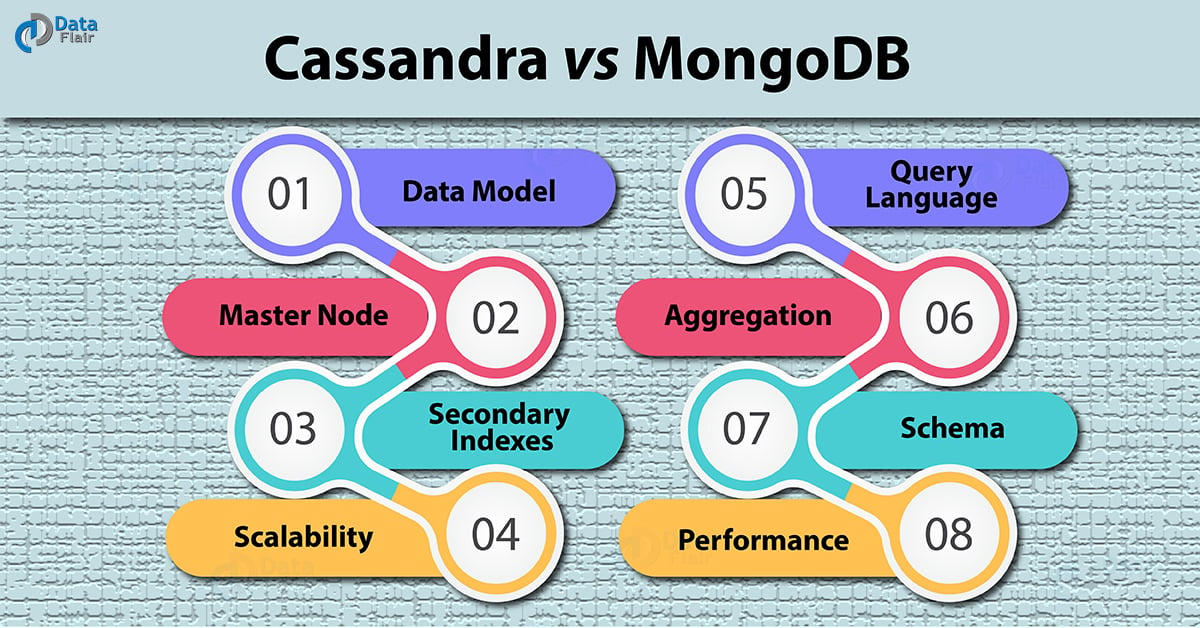Cassandra vs MongoDB – 8 Major Factors of Difference
FREE Online Courses: Click, Learn, Succeed, Start Now!
1. Objective
Today, in this Cassandra tutorial, we will discuss Cassandra vs MongoDB. In this, we will know the differences between Cassandra and MongoDB. In addition, we will discuss some similarities between MongoDB and Cassandra.
So, let’s start Cassandra vs MongoDB.
2. Similarities Between Cassandra and MongoDB
The similarity between Cassandra Vs MongoDB is, they both are NoSQL Databases. Both of them do not replace RDBMS, also they are not an ACID database.
When it comes to data requiring normalization and consistency, both Cassandra and MongoDB are a terrible choice.
Let’s Explore Cassandra vs HBase in detail.
Now, let’s begin to explore Cassandra vs MongoDB.
3. Cassandra vs MongoDB – Differences
Both Technologies plays a vital role in their fields. As their similarities show their common features and differences shows, uniqueness.
a. Data Model
- MongoDB
MongoDB has a rich and expressive data model. This data model is ‘object-oriented’ or ‘data-oriented’. This data model can easily represent any data structure in the domain of the user. In this, data can have properties and can be nested in each other for multiple levels.
Read more about MongoDB Data Modeling
- Cassandra
Technology is evolving rapidly!
Stay updated with DataFlair on WhatsApp!!
It is more of a traditional model with table structure including rows and columns. In this data model, data is more structured and each column has a specific type.
This type is entered during the creation of the table. When we compare both the models, MongoDB tends to provide a rich data model.
Read More about Cassandra Data Model
b. Master Node
- MongoDB
In MongoDB, there is only one master node in a cluster. This master node control a number of slave nodes. During a failure, when the master node goes down, one of the slave nodes is elected as master.
This process takes about 10 to 30 seconds. During this delay time, the cluster is down and cannot take any input.
- Cassandra
It has multiple master nodes in a cluster. Because of these multiple nodes, if one goes down, another takes its place.
Therefore, there is no effect on the cluster. Hence, the cluster is always available. Now, after comparing them both, Cassandra has higher availability than MongoDB.
c. Secondary Indexes
- MongoDB
It has secondary indexes are a first-class construct. Because of this, it is very easy to index any property of the data stored in the database. This property makes it easy to query.
Do you know about Cassandra Documented Shell Command
- Cassandra
It has cursory support for the secondary index. These indexes are limited to single columns and equality comparisons. If the application needs secondary indexes and needs flexibility in the query model, then MongoDB is better than Cassandra.
d. Scalability
- MongoDB
In MongoDB, there is only one master node. This master node only accepts the input. Apart from this, all the nodes are used as an output. Therefore, if the data has to be written in the slave nodes, it has to pass through the master node.
- Cassandra
Cassandra has multiple master nodes. To input data in the other nodes, these master nodes are used. Therefore, the more master nodes a cluster has, the better it will scale. After comparing the both, Cassandra has higher scalability than MongoDB.
Have a look at Casandra vs RDBMS
e. Query Language
- MongoDB
MongoDB, as of now, has no support for a query language. In MongoDB, the queries are structured as JSON fragments.
- Cassandra
Cassandra has its own query language. This query language is CQL. This query language or CQL is very similar to SQL. Hence, if we compare both on the basis of a query language, Cassandra is better than MongoDB.
f. Aggregation
- MongoDB
MongoDB has a built-in Aggregation framework. This framework is used to run an ETL pipeline to transform the data stored in the database.
This framework supports small and medium data traffic. Also, with increase in the complication, the framework start facing difficulties to debug.
Let’s discuss Cassandra Data Definition Command
- Cassandra
Cassandra does not have a built-in aggregation framework. Cassandra uses external tools like Apache Spark, Hadoop etc. After comparing the two, MongoDB is better than Cassandra when it comes to built-in aggregation framework.
g. Schema
- MongoDB
In MongoDB, a user has the ability to alter the enforcement of any schema on the database. Each database can be a different structure. It depends on the program or the application to interpret the data.
- Cassandra
Cassandra provides static typing. The user needs to define the type of the column in the beginning.
h. Performance
Let’s compare both of the databases according to their performance. We will compare them both according to a few criteria.
You must read about Cassandra Collection Data Types
i. Database Model
The performance according to database depends on the schemas. Some of the schemas work best in MongoDB and some in Cassandra.
ii. Load Characteristics
When it comes to heavy data load input, Cassandra is better than MongoDB. On the other hand, when it comes to heavy data load output, both are similar.
iii. Consistency Requirements
This criteria, depends on the input/output consistency of either database.
So, this was all about Cassandra vs MongoDB Tutorial. Hope you like our explanation.
Let’s discuss Cassandra Curd Operation – Create, Update, Read & Delete
4. Conclusion
In this tutorial, we went through Cassandra vs MongoDB in detail. We also learn the similarities between MongoDB and Cassandra.
Furthermore, if you have any query, feel free to ask in the comment section.
Related Topic- Hadoop vs Cassandra
Did you like our efforts? If Yes, please give DataFlair 5 Stars on Google



Which database is better for performing CRUD operations on time series data ?